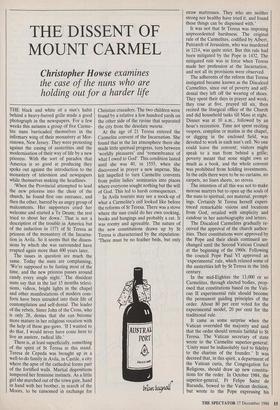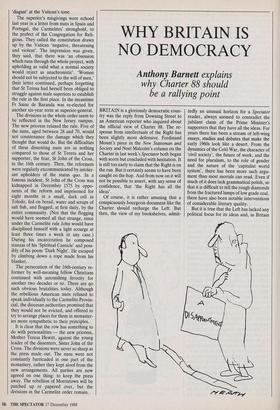THE DISSENT OF MOUNT CARMEL
Christopher Howse examines
the case of the nuns who are holding out for a harder life
THE black and white of a nun's habit behind a heavy-barred grille made a good photograph in the newspapers. For a few weeks this autumn a group of five Carme- lite nuns barricaded themselves in the infirmary wing of their monastery at Mor- ristown, New Jersey. They were protesting against the easing of austerities and the modernisation of their way of life by a new prioress. With the sort of paradox that America is so good at producing they spoke out against the introduction to the monastery of television and newspapers while themselves making the headlines.
'When the Provincial attempted to lead the new prioress into the choir of the church, he found first one entrance, and then the other, barred by an angry group of malcontents. Her supporters cried her welcome and started a Te Deum; the rest tried to shout her down.' That is not a description of the trouble in America but of the induction in 1571 of St Teresa as prioress of the monastery of the Incarna- tion in Avila. So it seems that the dissen- sions by which she was surrounded have erupted again more than 400 years later.
The issues in question are much the same. Today the nuns are complaining, 'We're supposed to be fasting most of the time, and the new prioress passes around candy every single night.' The dissident nuns say that in the last 15 months televi- sions, videos, bright lights in the chapel and other manifestations of modern com- forts have been intruded into their life of contemplation and self-denial. The leader of the rebels, Sister John of the Cross, who is only 28, denies that she can become more mature in her religious vocation with the help of these gee-gaws. 'If I wanted to do that, I would never have come here to live an austere, radical life.'
There is, at least superficially, something of the spirit of St Teresa in this stand. Teresa de Cepeda was brought up in a well-to-do family in Avila, in Castile, a city where the apse of the cathedral forms part of the fortified walls. Martial dispositions tempered her feminine instincts. As a little girl she marched out of the town gate, hand in hand with her brother, in search of the Moors, to be ransomed in exchange for Christian crusaders. The two children were found by a relative a few hundred yards on the other side of the ravine that separated the city from the desolate meseta.
At the age of 21 Teresa entered the Carmelite convent of the Incarnation. She found that in the lax atmosphere there she made little spiritual progress, torn between 'worldly pleasures' and 'remembrance of what I owed to God'. This condition lasted until she was 40, in 1555, when she discovered in prayer a new impetus. She felt impelled to turn Carmelite convents from polite ladies' seminaries into places where everyone sought nothing but the will of God. This led to harsh consequences.
In Avila tourists may see a mock-up of what a Carmelite's cell looked like before the reforms of St Teresa. There was a stove where the nun could do her own cooking, books and hangings and probably a cat. It was roomy and agreeable. The nature of the new constitutions drawn up by St Teresa is characterised by the stipulation: 'There must be no feather beds, but only
Wag
straw mattresses. They who are neither strong nor healthy have tried it, and found these things can be dispensed with.'
It was not that St Teresa was imposing unprecedented harshness. The original rule of the Carmelites, codified by Albert, Patriarch of Jerusalem, who was murdered in 1214, was quite strict. But this rule had been mitigated by the Pope in 1432. The mitigated rule was in force when Teresa made her profession at the Incarnation, and not all its provisions were observed.
The adherents of the reform that Teresa instigated became known as the Discalced Carmelites, since out of poverty and self- denial they left off the wearing of shoes. They spent their days in prayer and work; they rose at five, prayed till six, then recited the liturgical office of the Church and did household tasks till Mass at eight.
Dinner was at 10 a.m., followed by an hour's recreation. Time not spent reciting vespers, compline or matins in the chapel, or digging in the enclosed field, was devoted to work in each nun's cell. No one could leave the convent; visitors might speak to a nun from behind a grille; poverty meant that none might own so much as a book, and the whole convent was prohibited from holding investments. In the cells there were to be no curtains, no carpets, no linen sheets, no stoves.
The intention of all this was not to make morose martyrs but to open up the souls of the nuns to spiritual, not material, prompt- ings. Certainly St Teresa herself experi- enced remarkable visions and locutions from God, retailed with simplicity and candour in her autobiography and letters.
The Discalced Carmelites gradually re- ceived the approval of the church author- ities. Their constitutions were approved by the Pope and their ideals continued un- changed until the Second Vatican Council at the beginning of the 1960s. Following the council Pope Paul VI approved an 'experimental' rule, which relaxed some of the austerities left by St Teresa in the 16th century.
In the mid-Eighties the 13,000 or so Carmelites, through elected bodies, prop- osed that constitutions based on the Vati- can II experimental rule should become the permanent guiding principles of the order. About 80 per cent voted for the experimental model, 20 per cent for the traditional rule.
It came as some surprise when the Vatican overruled the majority and said that the order should remain faithful to St Teresa. The Vatican secretary of state wrote to the Carmelite superior-general: 'Unity must be indissolubly tied to fidelity to the charism of the founder.' It was decreed that, in this spirit, a department of the Vatican curia, the Congregation for Religious, should draw up new constitu- tions for the order. In October 1984, the superior-general, Fr Felipe Sainz de Baranda, bowed to the Vatican decision, but wrote to the Pope expressing his 'disgust' at the Vatican's tone.
The superior's misgivings were echoed last year in a letter from nuns in Spain and Portugal, the Carmelites' stronghold, to the prefect Of the Congregation for Reli- gious. They called the constitution drawn up by the Vatican 'negative, threatening and violent'. The impression was given, they said, that there was 'an obsession which runs through the whole project, with upholding as valid what a normal society would reject as anachronistic'. 'Women should not be subjected to the will of men,' their letter continued, perhaps forgetting that St Teresa had herself been obliged to struggle against male superiors to establish the rule in the first place. In the meantime Fr Sainz de Baranda was re-elected for another six-year term as superior-general.
The divisions in the whole order seem to be reflected in the New Jersey rumpus. The new prioress relaxed the rule. Five of the nuns, aged between 28 and 70, would not countenance the damage which they thought that would do. But the difficulties of these dissenting nuns are as nothing compared to those of St Teresa and her supporter, the friar, St John of the Cross, in the 16th century. Then, the reformers were regularly excommunicated by intoler- ant upholders of the status quo. In a famous incident, St John of the Cross was kidnapped in December 1575 by oppo- nents of the reform and imprisoned for eight months in a small, dark cell in Toledo, fed on bread, water and scraps of salt fish, and flogged, at first daily, by the entire community. (Not that the flogging would have seemed all that strange, since under the Carmelite rule John would have disciplined himself with a light scourge at least three times a week in any case.) During his incarceration he composed stanzas of his 'Spiritual Canticle' and poss- ibly of his poem 'Dark Night'. He escaped by climbing down a rope made from his blanket.
The persecution of the 16th-century re- former by well-meaning fellow Christians continued with astonishing ferocity for another two decades or so. There are qo such obvious brutalities today. Although the rebellious American nuns refused to speak individually to the Carmelite Provin- cial, the diocesan authorities promised that they would not be evicted, and offered to try to arrange places for them in monaster- ies more sympathetic to their principles.
It is clear that the row has something to do with personalities — the new prioress, Mother Teresa Hewitt, against the young leader of the dissenters, Sister John of the Cross. The divisions were never so sharp as the press made out. The nuns were not constantly barricaded in one part of the monastery, rather they kept aloof from the new arrangements. All parties are now agreed on one thing: to keep the press away. The rebellion of Morristown will be patched up or papered over, but the divisions in the Carmelite order remain.



























































 Previous page
Previous page